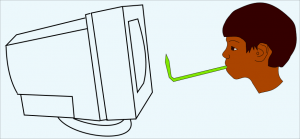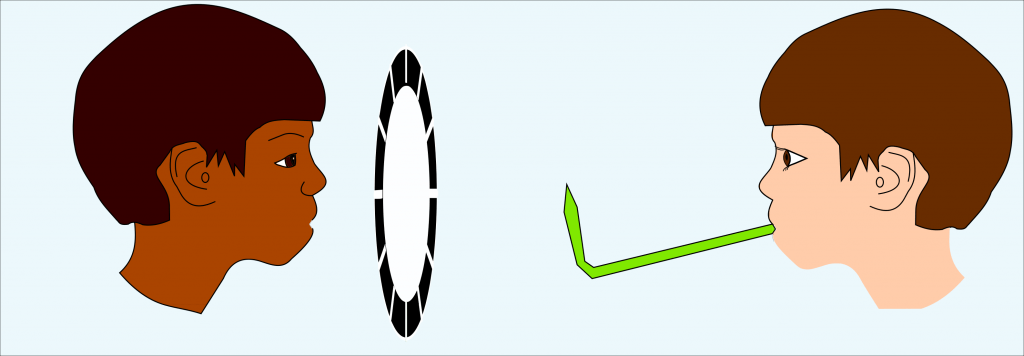ACTIVITY 1 Make the instrument play very low notes.
Simply tape another straw on. Notice what making the instrument lower does to pitch! How low can you go with how many straws?

ACTIVITY 2 Make the instrument play very low notes.
You need an old non-flat screen TV or computer monitor for this activity. The unplugged version of this activity is to view the reeds through the spinning slots of the movie wheel, which also provides a strobe effect.
Use the strobe effect of a TV to "slow down" the vibration.

Make another reed instrument, but this time do not cut it shorter. Test it. Bend your new instrument into an L shape and put the "wrong" end (the long part without the reeds) into your mouth as shown in the picture.
![]()
Adjust the straw so that you can see both reeds and the space in between them, as shown above. Instead of blowing air out, suck air in. You should not only get a sound, you should also be able to see the reeds become a blur of motion.
Adjust the straw so that you can see both reeds and the space in between them, as shown on the right. Instead of blowing air out, suck air in. You should not only get a sound, you should also be able to see the reeds become a blur of motion. TV acts as a strobe to "slow down" reed motion.

We can make the motion appear to slow down with the strobe effect. TVs and video monitors blink off and on with a new picture so fast we are not aware of it. Get within a foot or two of a computer monitor (best, because there is no distracting movement in the background) or TV. The brighter the screen, the better. View the vibrating reeds against the screen background. Notice how different pitches make different patterns.
NOTE: This strobe effect doesn't seem to work with liquid crystal display (LCD) screens--those flat screens on laptops and for desktop monitors, too.
The unplugged version of this activity is to view the reeds through the spinning slots of the movie wheel, which also provides a strobe effect.

Did you know?
Brass instruments use the player's lips as reeds.
Trumpets and tubas require the player to make sort of a raspberry against the mouthpiece.
Aulos--oboe-like instruments--were used in Olympic competitions by the ancient Greeks.
The oboe, with its double reed, is one of the instruments closest to our straw instrument. Other instruments have a single reed. Attempts to replace the troublesome real reeds with plastic reeds have failed so far. Reeds produce different sounds when hot, cold, or when played at high altitudes. Harmonicas have a rigid metal reed for each note.
I'd like to know how this project goes for you. I'm happy to answer questions about it. Feedback from you is an important way for me to know what works and what needs clarification.
